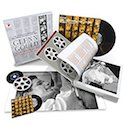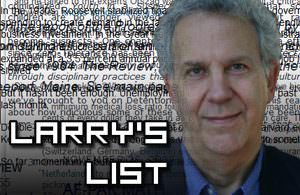Serkin, Gould and the Pianist’s Ideal
Recently available deluxe recordings from Rudolf Serkin and Glenn Gould reveal new secrets about these polar-opposite titans of classical piano. George Becker / CC 2.0
George Becker / CC 2.0
“Rudolf Serkin: The Complete Columbia Album Collection” Box set recording
“Glenn Gould: The Goldberg Variations: The Complete Unreleased Recording Sessions” Box set recording
Expansive yet forbidding, imperious yet embracing, pianist Rudolf Serkin mixed charm with guilt to build a towering legacy.
His recordings confirm him as a titan of the old school, a European who branded piano’s core repertoire with an air of authenticity. His philosophy of interpretive submission spurred rebelliousness in the next generation, and he hovers over classical piano’s firmament with peers like Arthur Rubinstein, Vladimir Horowitz and Mieczysław Horszowski.
By contrast, Glenn Gould, the Canadian, had enough peculiarities to fuel several careers.
Deluxe editions from these polar opposites reveal new secrets about the first century of piano recordings.
Gould made classical music’s best-selling album in 1955 by playing a dormant epic from Bach: “The Goldberg Variations.” Serkin performed and taught Bach, Mozart, Beethoven, Schumann and Brahms with a stern self-abasement, wincing whenever he had to “patch” a wrong note using a tape splice. To Serkin, this meant “cheating,” and sent his notorious practice regimen into overdrive.
In their recondite Serkin biography from 2003 (“Rudolf Serkin: A Life”), Stephen Lehmann and Marion Faber quote Thomas Frost, his longtime Columbia producer. Frost characterizes Serkin’s performance style better than many critics:
I could compare it to a mountain climber struggling to get up those rocks. And he succeeds, because he is so intent on succeeding and conquering the mountain. If some young person who is a naturally born athlete does it, it looks like child’s play. It’s less interesting, in a way. You don’t know whether the person who struggles is going to make it or not. And actually his struggle sometimes made his music making more interesting. It gave it more power, more poignancy. Some of the people who heard him practice at Marlboro thought that it was almost a masochistic ritual, that he could already play these passages, but he would do them over and over and over and over. It was his work ethic.

Purchase in the Truthdig Bazaar
Serkin made his American debut under Arturo Toscanini in 1936 and recorded almost until his death at 88 in 1991. Lehmann and Faber’s narrative provides an intimate view of how “Rudi,” beloved yet forbidding, presided over the classical world; now a handsome recording biography completes the picture. Sony’s career overview gathers 75 discs in their original album sleeves (shrunk-fit to CDs), a colossus that elevates Serkin’s status even as it confirms his conservative taste. He started out as an accompanist to his future father-in-law, violinist Adolf Busch, and carved his repertoire straight from the period that saw Beethoven expand and transcend the strict sonata forms of the classical era.
But Serkin’s musicianship came of age just as “neoclassicism” swept through music’s intelligentsia between the wars. Prokofiev wrote his “Classical” symphony in 1917, and Stravinsky adopted classical elements throughout his “Oedipus Rex” (1927) and “Symphony of Psalms” (1930). In this same period, Pablo Picasso veered from cubism into neoclassical, harking back to primitive ideas through elaborate new frames.
In reaction to an elitist avant-garde, this neoclassical ethic sought a rarefied humility, embodied by Serkin almost too well. As an Austro-Hungarian with the stiffest upper lip, Serkin didn’t put his stamp on music so much as hold up a glass windowpane to it; his reverence for the composer trumped both virtuosic display and emotional indulgence. So while Serkin counted Vladimir Horowitz as a friend, where the Russian played with a helpless demonic twinkle, Serkin strove to get out of the composer’s way. Serkin admired Horowitz, and considered Arthur Rubinstein the better pianist, but considered himself a better overall musician than either. (They all regarded Sergei Rachmaninoff as the best pianist ever.)
“Although I am a pianist, the piano has always been less interesting to me than music,” Lehmann and Faber quote Serkin as saying, and that hint of omniscience never felt lordly or patronizing.
Piano recordings capture an intimate dialogue between composer and interpreter. A given Beethoven sonata finds most of its virtues through a given player on a given session. Serkin discs, then, reflect how the “Appassionata” Sonata (discs 11, 38) sounds minus the pianist’s personality; he didn’t have a conversation with Beethoven so much as try to channel the score through his fingers. This ginormous box set contains many fascinating repetitions recorded years apart, and many have turned into Mount Rushmores—very few don’t make Top 10 lists, and more than a dozen have a curious sense of “definitive” about them, even though that’s a slippery concept (what if you hear a live performance of Brahms’ “Handel Variations,” disc 67, that outdoes Serkin’s “definitive” rendition?). Many hear Busch’s old-world influence through Serkin on Beethoven’s “Kreutzer” Sonata (disc 4), or the “Ghost” piano trio (with Hermann Busch, cello, disc 7), and the Schubert and Brahms Piano Trios (on disc 13). But that same exactitude courses through the Beethoven Cello Sonatas he plays with Pablo Casals (disc 17, 18 and 19), or the two Brahms Cello Sonatas with Rostropovich (recorded for Deutsche Grammophon, not included here).
One measure of how Serkin’s puritanical streak transcended flash lies in how he shied away from Chopin, a piano cornerstone. To him, Chopin’s flourishes veered too much toward self-indulgence. Few pianists back away from the Polish master’s seductive showpieces, but Serkin programmed only selected Etudes and recorded only the austere 24 “Preludes” in 1976 (disc 75), among Chopin’s more spare and pensive sets. Many wish he had taped at least one of the thrilling Chopin sonatas, the glorious “Barcarolle,” or some of the “Nocturnes,” but Serkin never did. Instead, you get passionately controlled readings of warhorses that grow in stature each time you listen.
Serkin’s core repertoire involves an idea about this core as intrinsic: all-consuming yet inscrutable. Very few ever measure up to Serkin’s Beethoven, especially his towering “Diabelli Variations” (a vast, erupting starburst, disc 28), three iridescent Fourth concertos (one with Toscanini, disc 44, two with Ormandy, discs 21 and 45), or the cloudburst and calm of his “Waldstein” sonata (disc 72). On sides like these, Serkin dramatizes Beethoven pressing hard against the structures of his era, breaking through to new horizons of feeling and vision. Some of these repetitions make you ache for the missing links: Schubert’s first “Piano Trio in B-Flat,” for example, or the remaining Brahms piano trios and quartets, and solo pieces from Opus 117 and 118. His masterful readings of the four pieces from Opus 119, disc 67, flirt with impressionism’s ethereal, but he never released the Debussy “Preludes” or “Etudes” he programmed. And a mid-60s Schumann “Carnaval” on YouTube from Carnegie Hall makes you fantasize about all the programs listed in Lehmann and Faber’s biography that never made the cut.
When he reaches beyond the traditional, Serkin finds brashness in moderation: Bartok’s “First Piano Concerto” sounds both punchy and restrained, a hyperactive gremlin in a straitjacket. Three discs sport works by the distant Max Reger: a “Piano Concerto” (disc 33), “Violin Sonata” (and cello sonata, featuring Rudolf’s son Peter, disc 70), and his “Variation and Fugue on a theme of Bach” (disc 69). Serkin championed these amenable tonal workouts even though he studied composition with atonality’s Yoda, Arnold Schoenberg.
The two most frequently recorded Serkin masterworks capture Brahms’ two mammoth piano concertos over the decades, the first a fearsome meditation on melancholy, which opens this box with Eugene Ormandy conducting the Philadelphia Orchestra, from 1946, and gets repeated in 1952 with George Szell (disc 15), Ormandy again in 1961 (disc 51), and Szell again in 1968 (disc 55). The second concerto chases a burnished, twilight mood that opens with a glistening horn solo and ascends into grand volleys between piano and orchestra (with Ormandy and Philadelphia from 1945, 1956 and 1960, discs 5, 22 and 32). Across four performances on these discs, you arrive at his 1966 peak with Szell and the Cleveland Orchestra (disc 53) atop a manifesto that somehow both conquers and enlarges this masterwork. Serkin plays deep inside the glorious sheen Szell commands, and together they strike preternatural rhythmic strokes in the Scherzo (second movement).
As sweeping as 75 discs feel, this box captures only one aspect of Serkin’s influence. In 1939, he began a 36-year teaching stretch at the Curtis Institute in Philadelphia, where he served as the school’s director between 1968 and 1975. In 1951, he founded the Marlboro Festival in Vermont with Busch, where he oversaw chamber music in all its forms, including Bach’s orchestral suites (with Pablo Casals conducting) and the many masterpieces for string quartet, quintet, and piano-with-strings compositions typically thought of as “small-room” music. Some of Lehmann and Faber’s best quotes surround Serkin’s practice habits: When the young violinist Arnold Steinhardt (who went on to lead the Guarneri Quartet) first came to stay at Serkin’s Marlboro Festival, he remembered waking up to a
pianist practicing scales painfully slowly, and I thought, “Who is this person who’s playing here? It’s obviously not a participant, it’s somebody at an intermediate level playing scales very, very slowly.” I thought, “Why do they let such a person who plays at this level in here?” And then the scales would slowly get faster and faster and in the stupor of my sleep I would think, “Well, it is getting better.” You know? And by the time I was awake, the guy or the girl was playing at full speed and it was very good. But the process from slow to fast was very, very slow, painfully slow… Then one day I got up early and went around back on the way to the dining hall, and bumped into Rudi, who was coming out of this room!
The Marlboro Serkin recordings combine his famous rigor with an elegant generosity, including his stately, immense Brahms “Horn Trio” (disc 34, with Myron Bloom and Michael Tree), Schubert’s “Auf Dem Strom,” with Benita Valente, soprano (again with Bloom’s horn), and the fabled Bach “Brandenburgs” (No. 1, 4 and 5) he played piano for under Casals’ baton (disc 52). Compressed fervor alternates with lingering sorrow in the Brahms and Schumann “Piano Quintets” (with the Budapest String Quartet, disc 42), and Schubert’s “Trout Quintet” (disc 54) paints a sunny Vermont countryside. Through his teaching, Serkin also mentored many of the next generation’s heroes (Eugene Istomin, Lee Luvisi, Richard Goode). Across this ocean of music, Serkin’s influence seems vast beyond comparison, forceful without ever sounding tiresome.

Purchase in the Truthdig Bazaar
If Serkin embodied tradition, Glenn Gould cultivated a platonic eccentricity, not just in style but form. He approached recording as a process unto itself, distinct from live performance and worthy of its own customs. His famous June 1955 sessions in Manhattan yielded a revelatory reboot of Bach’s “Goldberg Variations,” long considered a specimen of musicology—more for theory classes than concert halls. (Serkin’s musty “Goldberg” recording, available on YouTube, goes missing here.) At the dawn of Elvis Presley and Little Richard, when Leonard Bernstein made “crossover” glamorous, stepping up to the New York Philharmonic’s podium as his hit musical “West Side Story” ran on Broadway, Gould’s Bach had a startling, counterintuitive effect: He made this 1741 Baroque piece trendy. Gould’s extra-musical affects turned him into a Greenwich Village sensation, even among jazzers: He spurned the traditional piano bench to sit way down low on a customized, adjustable chair his father built for him, bringing his face closer to his fingers and keys. He hummed tunelessly as he played. His hair wagged loose with an unkempt flair, and his galloping tempos involved dazzling focus: Clocking in at under 40 minutes, his “Goldberg” served up Bach for the young and impetuous. He toured Russia in 1957, a year before Van Cliburn won the Tchaikovsky competition there, and made headlines with his slow-tempo Brahms First Piano Concerto, which Bernstein renounced before conducting.
He can take credit for turning the “Goldberg” into a modern showpiece that now launches careers (Simone Dinnerstein, 2007), anchors legacies (András Schiff, 2002), and marks a notch in any striver’s development (Lars Vogt, 2015, and a gorgeous new reading from Beatrice Rana, 2017). Gould famously rerecorded the “Goldberg” set in 1981 and died of a stroke soon after its release the next year. Many think of these as defining bookends without mentioning two other important dates: a live Salzburg recording that Sony eventually released in 1993, and a CBC radio broadcast from 1954 that helped him win his first recording contract. The Salzburg disproves those who write Gould off as a creature of the studio, unable to reproduce his effects live. And this latest deluxe package of his 1955 venture includes all the original outtakes to show just what a workhorse this early effort proved. Many musicians still regard modern recording as a dodge, a way of weaving only the best takes into an ideal whole. Gould’s outtakes reveal a seeker in the best sense, who flavors Bach passages with obsessive zeal, finds renewed variation with each take, harnessing a protean, laser-beam attention to detail. The “final cut” of this early “Goldberg” indeed stitches together many different takes for a tapestry from grueling sessions, but his Salzburg performance replicates many of the same fleet tempi and daring that give the lie to his musical dependence on privacy.
The early set rewards close listening for a surging, motoric energy behind the swift passages and a yearning to the slower ones. As Paul Elie writes in “Reinventing Bach” (2012), his commanding overview of Bach’s recorded legacy:
Conceived in solitude, in the company of a tape recorder, they are sociably gregarious. Gould was taken with Ralph Kirkpatrick’s image of the work as a classical palace or temple with “the variations grouped like the member of an elaborate colonnade”—in ten groups of three, with each group “composed of a canon and an elaborate two-manual arabesque, enclosing in each case another variation of independent character.”
The later set begins deep in melancholy, almost too slow to sustain, and gets moody from there. Apparently, Gould set up these later tempos in order to balance out lengths between variations, to give Bach’s canons a larger architectural sweep. They remain inimitable, if not for everybody. Even those who steer away from Gould’s peculiarities (and they could prove distracting) admit he brought new freedoms not just to Bach but the standard fare Serkin championed. His Mozart could prove uneven and effete, but he excelled with hyper-radicals like Berg and Hindemith.
Hearing Beethoven or Brahms through a transparent pane, of course, works only if you have a thoughtful interpretation working for you; Serkin’s “humility” was, in a sense, just another performative illusion. (And when Gould plays Liszt’s transcription of Beethoven’s “Pastoral” symphony, he imagines some fairly droll rustic dancers.) What Serkin displays most ardently throughout these large-scale works involves attention to structure and longer compositional lines, phrases that carry you from the first note through to the last. As his father-in-law Busch said of his playing, “The way the boy plays, you see the whole score in front of you.” It’s more than his head ruling his heart, though: Serkin persuades you that any well-built piece bakes emotion into form, and that an interpreter can plumb the enigmas of great music by illuminating the gears turning beneath its themes.
Your support matters…Independent journalism is under threat and overshadowed by heavily funded mainstream media.
You can help level the playing field. Become a member.
Your tax-deductible contribution keeps us digging beneath the headlines to give you thought-provoking, investigative reporting and analysis that unearths what's really happening- without compromise.
Give today to support our courageous, independent journalists.



You need to be a supporter to comment.
There are currently no responses to this article.
Be the first to respond.